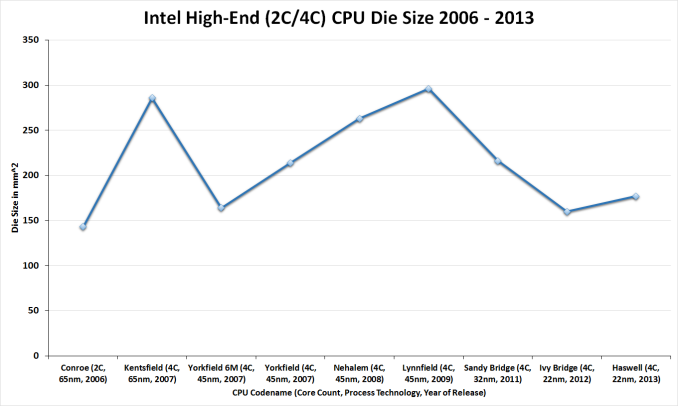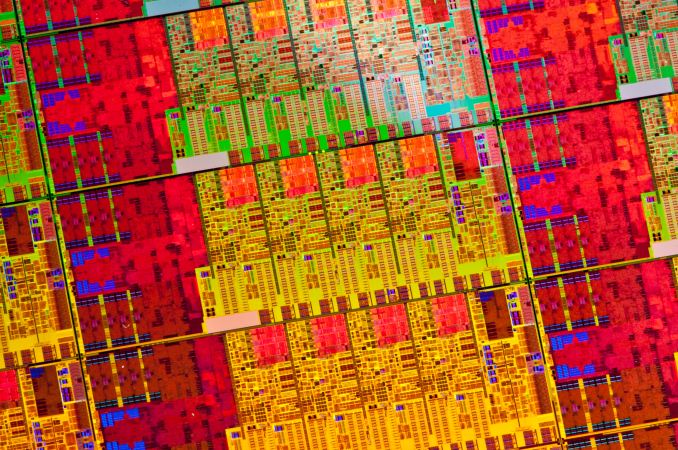The Haswell Review: Intel Core i7-4770K & i5-4670K Tested
by Anand Lal Shimpi on June 1, 2013 10:00 AM ESTDie Size and Transistor Count
Moving on to die sizes and transistor counts, this year Intel is striving to be more straightforward and accurate than was the case with Sandy Bridge and Ivy Bridge. With the Bridge generation we didn’t initially get comparable numbers, only for the correction to throw in additional confusion. For Haswell Intel is laying things out from the start, listing both possible numbers so that either can be compared.
| CPU Specification Comparison | |||||||||
| CPU | Manufacturing Process | Cores | GPU | Transistor Count (Schematic) | Die Size | ||||
| Haswell GT3 4C | 22nm | 4 | GT3 | ? | 264mm2 (est) | ||||
| Haswell GT2 4C | 22nm | 4 | GT2 | 1.4B | 177mm2 | ||||
| Haswell ULT GT3 2C | 22nm | 2 | GT3 | 1.3B | 181mm2 | ||||
| Intel Ivy Bridge 4C | 22nm | 4 | GT2 | 1.2B | 160mm2 | ||||
| Intel Sandy Bridge E 6C | 32nm | 6 | N/A | 2.27B | 435mm2 | ||||
| Intel Sandy Bridge 4C | 32nm | 4 | GT2 | 995M | 216mm2 | ||||
| Intel Lynnfield 4C | 45nm | 4 | N/A | 774M | 296mm2 | ||||
| AMD Trinity 4C | 32nm | 4 | 7660D | 1.303B | 246mm2 | ||||
| AMD Vishera 8C | 32nm | 8 | N/A | 1.2B | 315mm2 | ||||
The two numbers for the most common Haswell configuration, Haswell GT2 4C, are 1.4 billion schematic transistors and 1.6 billion layout transistors. Why and what is the difference? The former count is the number of transistors in the schematic (hence the name), and is generally the number we go by when quoting transistor counts. Meanwhile the second number, the layout number, is the number of transistors used in the fabrication process itself. The difference comes from the fact that while the schematic will use one large transistor – being a logical diagram – production will actually use multiple transistors laid out in parallel for layout and process reasons. So how many transistors does Haswell have? It has both 1.4B and 1.6B, depending on which number we’re after, with 1.4B being the number Intel is passing around.
In any case, even among quad cores Haswell is going to come in a couple of different sizes. Along with the 1.4B transistor, 177mm2 4C/GT2 version of Haswell, there is the 4C/GT3 version of Haswell, which Intel doesn’t list the die size or transistor count for. Based on our rough measurements of the physical die we’re at 264mm2, which including the epoxy covering the die will run a bit large.
Breaking things down to the GPU portion of Haswell, based in turn on these measurements I came up with an 87mm^2 adder for the extra hardware in Haswell GT3 vs. GT2. Doubling that 87mm^2 we get a rough idea of how big the full 40 EU Haswell GPU might be: 174mm^2. If my math is right, this means that in a quad-core Haswell GT3 die, around 65% of the die area is GPU. This is contrary to the ~33% in a quad-core Haswell GT2. I suspect a dual-core + GT3 design is at least half GPU. Meanwhile Crystalwell, the 128MB eDRAM, adds another 84mm2 die (by our measurements) to the entire package.
On a comparative basis, the 4C/GT2 version of Haswell is roughly 200M transistors and 17mm2 bigger than the comparable 4C/GT2 version of Ivy Bridge. The transistor count increase is roughly what we’d expect, with most of those transistors going to Haswell itself while the GPU remains relatively unchanged. Though it’s interesting to note that while this marks a 17% increase in transistors, it’s only an 11% increase in die size. Ivy Bridge was a small die for an Intel, and while Haswell grows larger in exchange for the additional functionality the new architecture provides, it’s still a fairly small GPU and reaches a density greater than Ivy Bridge itself. Or to put this another way, Intel’s last tock CPU, Sandy Bridge, was larger still by almost 40mm2. It’s only once we start adding the relatively big GT3 GPU, and not the CPU, that we see Intel go well above 200mm2.












210 Comments
View All Comments
smoohta - Saturday, June 1, 2013 - link
Blah, seems like a rather shallow review:1. What about benchmarks to take advantage of the new AVX2 instructions? (FMA specifically would be interesting)
2. Same for TSX?
Klimax - Sunday, June 2, 2013 - link
I know only about x264 having it in the last versions. Not sure who else has it.Gigaplex - Saturday, June 1, 2013 - link
"Here I’m showing an 11.8% increase in power consumption, and in this particular test the Core i7-4770K is 13% faster than the i7-3770K. Power consumption goes up, but so does performance per watt."So... performance per watt increased by ~1%. For a completely new architecture that's supposedly all about power optimisation, that's extremely underwhelming to say the least.
Homeles - Saturday, June 1, 2013 - link
Haswell is not focusing on the desktop I'm not sure how you managed to believe that it is.krumme - Saturday, June 1, 2013 - link
Because Anand is a fan of it, even at desktop?MatthiasP - Saturday, June 1, 2013 - link
So we get +10% performance increase for +10% increase in energy consumption? That's rather disappointing for a new generation.jeffkibuule - Saturday, June 1, 2013 - link
Haswell is movinig voltage regulators that were already on the motherboard on die, so power consumption hasn't changed, it's just that the CPU cooling system has to deal with that extra heat now. Remember that those power ratings are NOT about how much power the chip uses, but how much cooling is needed.Homeles - Saturday, June 1, 2013 - link
System power consumption with Haswell is, in fact, higher. Take a look at page 2.Still, when you're running at these kind of frequencies, 10% more performance for 10% more power is a big deal. If you were to hold back the performance gains to 0%, power savings would be greater than 25%.
The only reason Piledriver was able to avoid this was because it was improving on something that was already so broken. AMD's not immune to the laws of physics -- when they catch up to Intel, they will hit the same wall.
Klimax - Sunday, June 2, 2013 - link
Most likely sooner, because they can't fine tune process.dgz - Saturday, June 1, 2013 - link
I agree but Intel has been doing that for many years. I just don't get what they're gaining by artificially restricting IOMMU support.